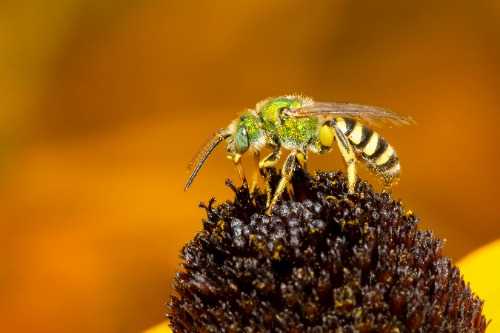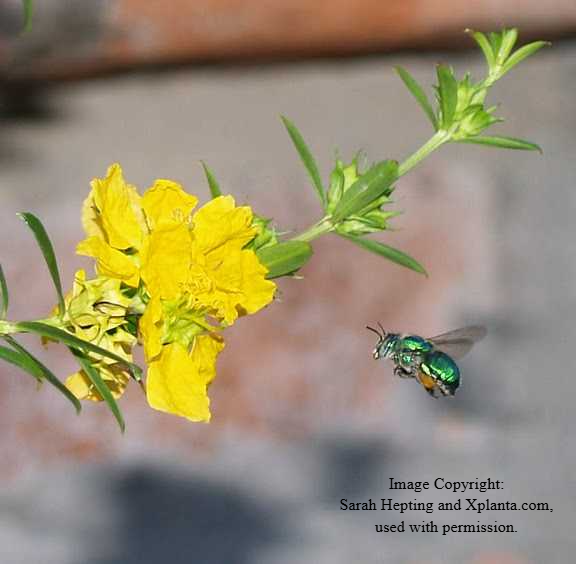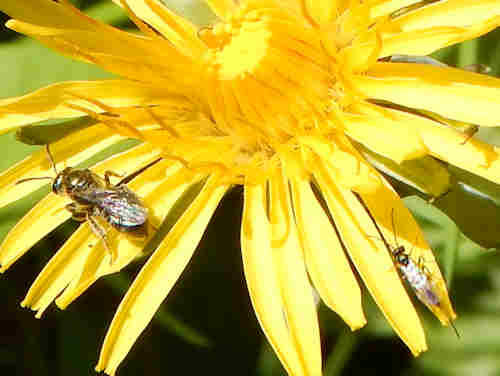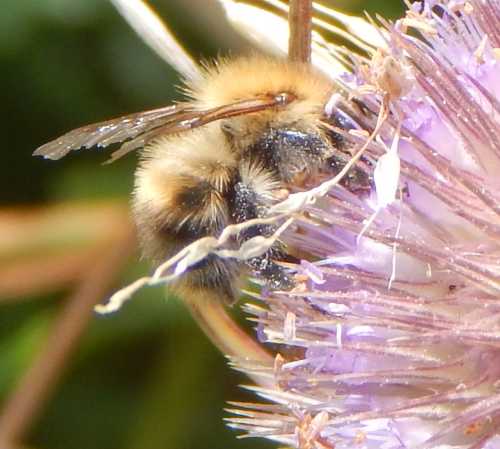Green Bees
I had a query asking "What insect looks like a bee, but is green?"
My immediate response was, if you have seen a flying green insect foraging on flowers that looked like a bee, it quite probably was a bee!
Yes, some bees really are green! I decided to write a page taking a look at green bees.
Green Bees
Across the world, there is abundant variety in the appearance of bees. For instance, there are bees with red bodies (e.g. the blood bees), and bees with iridescent violet bodies.
Elsewhere on my website, I have already mentioned that some bee species have green eyes, but the bodies of other species can take on glorious metallic shades, including green, as you can see on the 'green bee' video gallery.
So which bees are green?
Green bee species can be found in a number of different bee tribes and genera, in particular:
- members of the Augochlorina tribe,
- the genus Agepostemon (green sweat bees), and
- some species of the genus Euglossa,
- some species of the Osmia, Lasioglossum and (according to Wilson & Messinger Carril, authors of 'The Bees In Your Backyard') even the Andrena genera.
The Agepostemon genus
 Agepostemon species - Striped Sweat Bee.
Agepostemon species - Striped Sweat Bee.These bees can occur in beautiful bright shades of blue or metallic green. This genus of bees is found only in the Western Hemisphere, and there are approximately 14 species in the USA.
There are around 45 species from northern Canada to Argentina, and some are found on the Carribean islands.
Some bee species within this genus are completely green (see the video gallery), whilst others have a metallic head and thorax with a striped abdomen and are commonly referred to as 'striped sweat bees'.
Agepostemon are known to forage on a range of flowers from a variety of plant families, including sunflowers and other Asteraceae.
They nest in the ground, even in lawns, on slopes or vertical banks. Nests are usually in a solitary setting, although a few will nest communally, with females creating their own nest within a shared burrow. Different species will sometimes nest in close proximity to each other.
Agepostemon are included in the Halictidae bee family.
According to Wilson & Messinger Carril the word Agepostemon means 'stamen loving'.
Green Euglossa bees
 Euglossa species
Euglossa speciesEuglossa species are found in shades of metallic blue, copper and green. The name 'Euglossa' means 'well-tongued', referring to the long tongues of these species. They are members of the Apidae bee family.
Euglossa are native to the tropics of Central and South America, with a few species found in the mountains of northern Mexico.
Male Euglossa collect scent compounds from flowers which are thought to play a role in courtship, although what that role is may be unclear1.
Euglossa are commonly referred to as 'orchid bees', due to the fact that the males of many species collect the scents from orchid flowers, and play a key role in the pollination of orchid species.
Female Euglossa forage not only for nectar and pollen, but also for resin which they use in nest construction. Euglossa are cavity nesters and will make use of natural and man-made cavities.
In the short video gallery on this page, do take a look at the hind legs of these species. In both males and females, the hind legs are adapted for collecting scent compounds or resins.
Green bees in the Augochlorina tribe
This tribe of bees includes:
The Augochlora genus
Augochlora is Greek for 'exceedingly green'.
Around 120 species are found in South America, 3 species in USA and 1 in Canada.
Forage on a range of flowers.
Nest mostly under bark and rotting wood.
The Augochlorella genus
Augochlorella is Greek for 'little Augochlora'.
The color range is copper to green.
There are approximately 20 species worldwide, with 5 in the USA and 2 species known in Canada.
The Augochloropsis genus
Augochloropsis is Greek for 'looking like Augochlora'.
Vibrant, shiny green bees.
3 species recorded in the USA and Canada.
These bees nest in the soil.
The Pseudoaugochlora genus
Pseudoaugochlora is Greek for 'false Augochlora'.
Only 1 species is known in the USA.
There are 7 Pseudoaugochlora species recorded in Brazil2.
In general, these bees are metallic green although of them may have tints of red, gold, blue or even black on some parts or most of the body2.
Osmia, Lasioglossum and Andrena genera
The Osmia, Lasioglossum and according to Messinger, Andrena genera include a number of green-tinged species across the globe.
For example, Lasioglossum smeathmanellum is a very small, green-tinged metallic bee found in a range of geographical regions.
 Lasioglossum smeathmanellum bees (female left and a male, right)
Lasioglossum smeathmanellum bees (female left and a male, right)References
1. Eltz, T., Roubik, D.W. and Whitten, M.W. (2003), Fragrances, male display and mating behaviour of Euglossa hemichlora: a flight cage experiment. Physiological Entomology, 28: 251-260. https://doi.org/10.1111/j.1365-3032.2003.00340.x
2. Almeida, Eduardo. (2008). Revision Of The Brazilian Species Of Pseudaugochlora Michener 1954 (Hymenoptera: Halictidae: Augochlorini). Zootaxa. 1679. 10.5281/zenodo.180374.
Other major resource for the writing of this article: Wilson & Messinger Carril, authors of 'The Bees In Your Backyard'.
